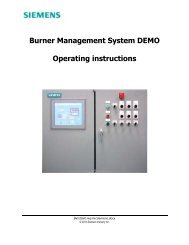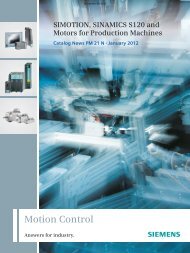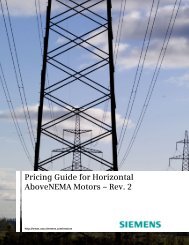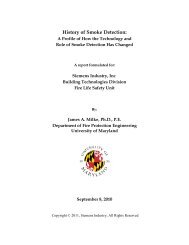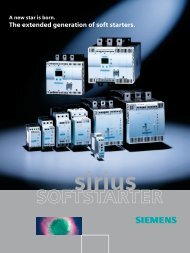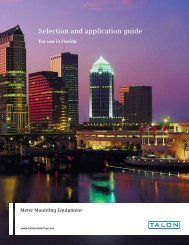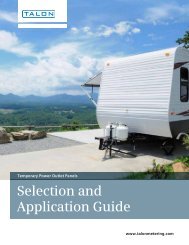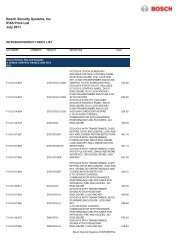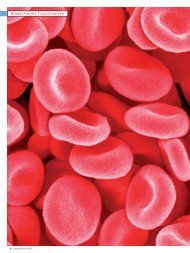Sleeve vs Antifriction Bearings - Siemens Industry, Inc.
Sleeve vs Antifriction Bearings - Siemens Industry, Inc.
Sleeve vs Antifriction Bearings - Siemens Industry, Inc.
Create successful ePaper yourself
Turn your PDF publications into a flip-book with our unique Google optimized e-Paper software.
coupled. This can be a significant feature if riggingrequirements make it extremely difficult to remove themotor.Anti-friction bearings failures tend to be catastrophic innature, oftentimes providing little prior warning. In somecases the bearings fail to the point of having the rotor dropdown into the stator, essentially destroying the entiremotor. Even if the entire motor is not damaged, the shaft(and thus rotor assembly) must oftentimes be replacedafter a catastrophic bearing failure, as the inner race tendsto first spin and later weld itself to the shaft.When sleeve bearings fail, they tend to be lesscatastrophic, and generally provide information as to thedegrading state of the bearings. When the bearings failcatastrophically, the bearing itself tends to be sacrificial,as the bearing babbit is much softer than the shaft steel.Generally it is possible to clean up the shaft with minorregrinding of the bearing journal surface.V. PERFORMENCEA. Efficiency <strong>vs</strong>. Bearing TypeIt is sometime asked whether anti-friction bearings canachieve better efficiency than sleeve bearing machines. Ingeneral the answer is that the difference is insignificant..A/F bearings do normally generate fewer losses butnormally the losses are a small percentage of the totallosses having little effect on the total efficiency. Regardingthis question, the following example for a 500 frame 2 pole300 HP and 1250 HP motor may help:Total. Brg. Efficiency .Loss Loss A/F <strong>Sleeve</strong>W/O in kW Brg. BrgHP Brg. A-F / <strong>Sleeve</strong>.. Loss .300 13.5 .52/ .75 94.09 94.001250 46.7 .52/ .75 95.17 95.15As can be seen from the above, the difference is small.B. Service life <strong>vs</strong>. Theoretical lifeThe calculated life expectancy of any bearing is based onfour assumptions.1) Good lubrication in proper quantity will always beavailable to the bearing.2) The bearing will be mounted without damage.3) Dimensions of parts related to the bearing will becorrect.4) There are no defects inherent in the bearing.In general, sleeve bearings have an extremely long life.Anti-friction bearings that are oil mist or sump lubricatedalso do and will reach their expected L10 fife. Greaselubricated bearing rarely reaches their expected L10 life.C. Rotor-Dynamic PerformanceBearing selection can have a significant impact on rotordynamic performance. Table III shows the results of acase study of a similar motor with different bearings. Therotor under study was for a 3600 RPM 1250 Horsepoweropen motor. The rotors were similar, with the obviousexception of bearings (and the required subsequentchanges in the shaft).Notice that as the stiffness decreases, so does theresonant frequency. However, highly damped resonancesare not considered to be critical speeds. Per API 684,amplification factor is defined as a measure of a rotorbearingsystems vibration sensitivity when operated in thevicinity of one of its lateral critical speed [3]. Furthermore,this same standard defines critical speed as a shaftrotational speed that corresponds to a non-criticallydamped (amplification factor >2.5) rotor system resonancefrequency. This is an important definition as a highlydamped resonance should not be misinterpreted as acritical speed. The justification in this lies in the fact thateven if a motor were to operate right at this speed, theincrease in vibratory response would be so low that nodamage to the motor or bearings would occur. This isevident when reviewing the calculated rotor dynamicperformance of the 150 Partial arc sleeve bearing to the6315 anti-friction bearing, in particular, with respect to therotor response to unbalance as illustrated in Fig. 11:Fig. 11 compared the predicted increases in vibration dueto an unbalance of 4W/N, which is equal to the residualunbalance limit for each end of the rotor in API 541motors. The peak to the right corresponds to the 6315AFB bearing, and the peak to the left, the 150 degreepartial arc bearing. Note the significantly different scalesfor the two curves (6315 corresponds to the scale on theright, and the 150 degree partial arc, the scale to the left).Furthermore, note that the vibration of the 6315 rotorwould be 34 times higher at its resonant speed comparedto operating speed. Clearly, vibration severity of thismagnitude cannot be tolerated for any period of time.150 <strong>Sleeve</strong> BearingVibration mils Pk-Pk0.30.250.20.150.10.05010001500Rotor Response to Unbalance (4W/N)2000250030003500400045005000Rotor Speed - RPMFig. 11 Rotor response to unbalance550060006500700032.521.510.506315 AFB Vibrationmils Pk-PkLikewise, the 150-degree partial arc-bearing rotor wouldbe 1.2 times higher at its resonant speed compared tooperating speed. The rotor can operate at this speedindefinitely without any harm to the rotor or bearing.Page 11 of 13



